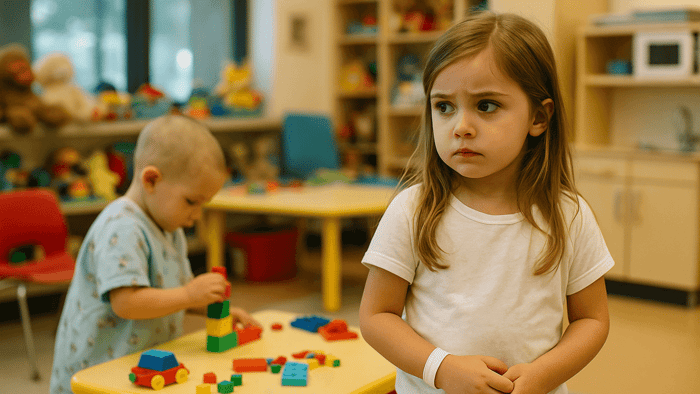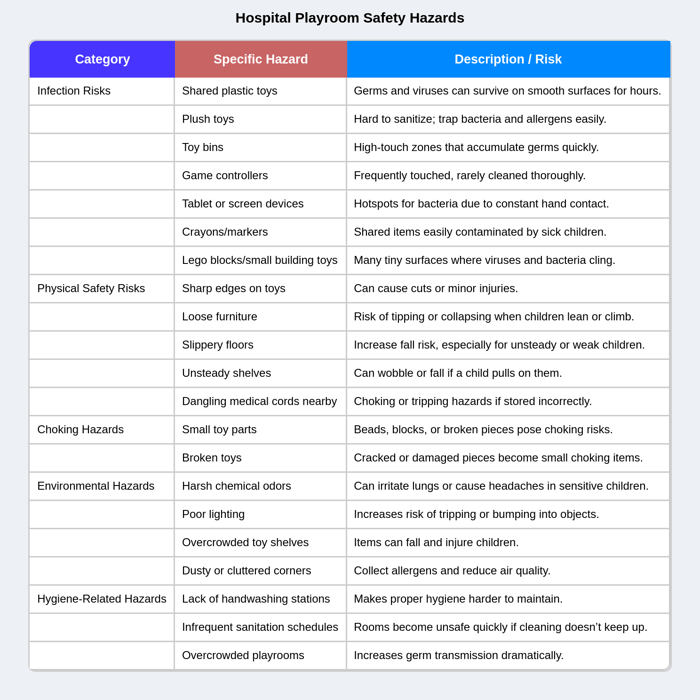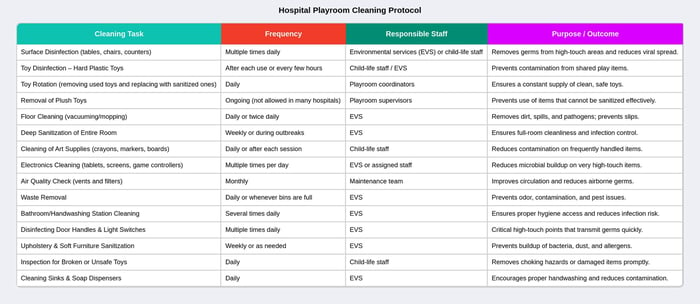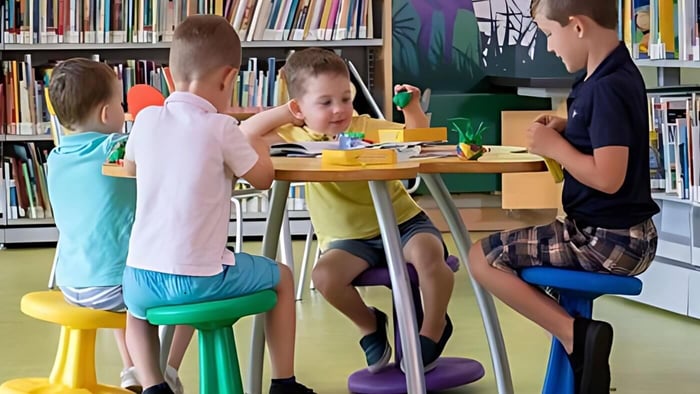
The Shocking Dangers Hiding in Hospital Playrooms
Table of Contents
- Hospital administrators know pediatric playrooms boost patient recovery, but shocking research reveals 84% of hospital toys harbor dangerous bacteria including antibiotic-resistant pathogens. Discover which materials pose the highest contamination risks and the enhanced protocols protecting immunocompromised children.
- Key Takeaways
- 84% of Hospital Toys Show Microbial Contamination
- Critical Infection Pathways in Pediatric Playrooms
- Physical and Chemical Environmental Hazards
- Evidence-Based Disinfection Protocols
- Enhanced Protocols for Immunocompromised Patients
- Implementation Framework for Hospital Administrators
- Strict Controls Transform Playrooms from Risk to Recovery Tool
- FAQs
Hospital administrators know pediatric playrooms boost patient recovery, but shocking research reveals 84% of hospital toys harbor dangerous bacteria including antibiotic-resistant pathogens. Discover which materials pose the highest contamination risks and the enhanced protocols protecting immunocompromised children.
Key Takeaways
- Studies reveal that 84% of hospital toys harbor microbial contamination, including pathogenic bacteria like Staphylococcus aureus and Acinetobacter baumannii
- Plastic toys show the highest contamination rates at 91.9 CFU/cm², making material selection critical for infection control
- Immunocompromised patients require enhanced protocols including single-use soft toys and disinfection before and after each use
- Daily cleaning of high-touch items and hospital-approved disinfectants form the foundation of effective playroom safety programs
- Staff training and documentation systems ensure consistent implementation of infection control measures
Hospital playrooms serve as vital therapeutic spaces that support children's psychological well-being during treatment. However, these seemingly safe environments can harbor significant infection and environmental risks that require careful management by healthcare administrators. Understanding these hazards and implementing evidence-based control measures transforms playrooms from potential risk sources into valuable recovery tools.
84% of Hospital Toys Show Microbial Contamination
Research conducted across multiple hospital departments reveals alarming contamination rates in pediatric playrooms. A 2021 study analyzing 120 toys found that 84% of samples contained various microorganisms, with four distinct genera and thirty-seven bacterial species identified. The most frequently isolated pathogen was Sphingomonas paucimobilis, detected at concentrations exceeding 603 CFU/cm². While many identified microorganisms represent normal human microbiota, concerning pathogens including Staphylococcus aureus and Acinetobacter baumannii were also present on toy surfaces, though these specific pathogens showed sensitivity to antibiotics in the study.
Plastic toys demonstrated the highest average contamination rates at 91.9 CFU/cm² according to the 2021 research, significantly exceeding other materials. This finding highlights the critical importance of material selection in playroom design and the need for targeted cleaning protocols based on surface types. Little People's Cove specializes in developing infection-conscious playroom solutions that address these contamination challenges through strategic design and material selection.
The high contamination rates stem from frequent child-to-toy contact, inconsistent cleaning protocols, and children's natural behaviors including mouthing objects and limited hand hygiene awareness. These factors create perfect conditions for microbial transmission, particularly concerning given that pediatric patients often have compromised or developing immune systems.
Critical Infection Pathways in Pediatric Playrooms
1. High-Risk Contact Points and Contamination Sources
Hospital playrooms contain numerous high-touch surfaces that facilitate pathogen transmission. Small, hand-held toys require daily disinfection due to frequent handling, while large stationary equipment needs weekly cleaning protocols. Contact points extend beyond toys to include furniture, door handles, and play surfaces that children frequently touch during activities.
Contamination occurs through multiple pathways including respiratory droplets from coughing or sneezing children, direct skin contact with infected surfaces, and fomite transmission through shared objects. The challenge intensifies in hospital settings where children may have underlying conditions that increase shedding of pathogens or reduce their ability to fight infections.
2. Pathogenic Bacteria Detection on Toy Surfaces
Laboratory analysis reveals bacterial presence on hospital playroom toys, though findings vary across studies. While the 2021 study found that detected CFU/cm² levels for dangerous pathogens like Staphylococcus aureus and Acinetobacter baumannii remained relatively low and showed antibiotic sensitivity, their presence indicates potential transmission risks that require immediate attention.
The diversity of identified microorganisms varies significantly across hospital departments. Cardiology, cardiac surgery, and general surgery departments showed different contamination patterns compared to gastroenterology, rheumatology, and endocrinology units, suggesting that department-specific protocols may be necessary for optimal infection control.
3. Immunocompromised Patient Vulnerability Factors
Children receiving treatment for cancer, organ transplants, or other conditions that suppress immune function face heightened infection risks in playroom environments. Their bodies cannot effectively fight off even low-level pathogen exposures that healthy children might easily overcome. This vulnerability necessitates enhanced protective measures including restricted access policies and intensified cleaning protocols.
Hospitals like Children's Health in Dallas demonstrate proactive approaches by restricting playroom access for children in isolation or those with fever in the last 24 hours, though such policies may vary across different healthcare facilities. Such policies recognize that prevention strategies must account for varying patient risk levels and current health status.
Physical and Chemical Environmental Hazards
1. Furniture and Equipment Safety Risks
Beyond infectious agents, hospital playrooms present physical safety challenges that require systematic risk assessment. Unsecured furniture poses tipping hazards, while equipment with small openings can trap children's heads or limbs. Tripping hazards from poorly maintained surfaces and inadequate cushioning under play equipment contribute to injury risks.
Regular safety inspections must evaluate structural integrity, proper anchoring of heavy items, and age-appropriate design elements. Toys and equipment showing signs of wear or damage require immediate removal, as worn surfaces can harbor additional contaminants and create sharp edges or choking hazards.
2. Chemical Emissions from Play Materials
Certain play materials, particularly foam mats and plastic toys, may emit harmful chemicals including formaldehyde. These emissions can cause respiratory irritation and other health effects, especially concerning for children with existing respiratory conditions or chemical sensitivities. Material selection should prioritize low-emission products that meet strict safety standards for healthcare environments.
Chemical hazards extend to cleaning products used in hospital playroom maintenance. While disinfection is necessary, cleaning agents must be hospital-approved and applied according to manufacturer guidelines to prevent harmful residue exposure. Proper ventilation during and after cleaning activities helps minimize chemical exposure risks.

Evidence-Based Disinfection Protocols
Daily Cleaning Requirements for High-Touch Items
Healthcare guidelines recommend establishing policies for cleaning and disinfecting toys at regular intervals, with daily attention to frequently handled items. Small, hand-held toys require cleaning after each use or when visibly soiled, while stationary toys need daily disinfection when in regular use. Large stationary toys should receive weekly cleaning, with increased frequency if visibly dirty or heavily used.
UCSF Health exemplifies best practices by mandating cleaning of stationary toys with hospital-approved disinfectants at least once daily when in use and immediately when visibly soiled. This approach ensures consistent pathogen removal while maintaining practical implementation standards for busy healthcare environments.
Practical Soft Toy Management Guidelines
Soft toys present unique challenges due to their porous materials and difficulty in thorough disinfection. Many healthcare facilities address this challenge by restricting soft toys to single-patient use only, with communal soft toys prohibited entirely. This policy eliminates cross-contamination risks while allowing children to benefit from comforting soft toys during their stay.
When soft toys are provided, they should be new, machine washable items that can be laundered at 60°C to ensure proper disinfection. Healthcare guidelines recommend this temperature standard for all machine washable play area items, as lower temperatures may not eliminate all pathogens effectively.
Hospital-Approved Disinfectant Standards
Disinfectant selection requires careful consideration of efficacy, safety, and compatibility with different materials. Hospital-approved products must demonstrate effectiveness against relevant pathogens while maintaining safety profiles appropriate for pediatric environments. Contact time requirements vary by product and must be strictly followed to ensure pathogen elimination.
Cleaning procedures typically involve initial washing with soap and water followed by disinfectant application with appropriate dwell time. Toys likely to be mouthed require rinsing after disinfection, and dishwasher-safe items can utilize automated cleaning cycles for consistent results. Single-use cleaning cloths prevent re-contamination during the cleaning process.
Enhanced Protocols for Immunocompromised Patients
1. Material Selection and Toy Restrictions
Toys for immunocompromised patients must be constructed from materials that withstand rigorous cleaning protocols. Plastic, vinyl, metal, and finished wood surfaces allow effective disinfection, while soft, stuffed toys and water-retaining items are generally prohibited or restricted to single-patient use. This material focus ensures that cleaning efforts achieve maximum pathogen elimination.
Therapeutic or instructional items used with immunocompromised patients require thorough cleaning after each use. The selection process should favor hard surfaces that can withstand mechanical cleaning without degradation, ensuring long-term usability while maintaining safety standards.
2. Isolation Room Cleaning Procedures
Toys used in isolation rooms face the highest contamination risks and require the most stringent cleaning protocols. Items must be disinfected with hospital-approved products before being returned to storage, and many facilities require toys to remain with patients throughout their isolation period to prevent cross-contamination.
Contact, droplet, and airborne isolation rooms each present unique challenges requiring specific handling protocols. Toys brought from home must be cleaned with hospital-approved disinfectants before use and require cleaning after each use session. These measures protect both the patient and other children who might use the items after discharge.
3. BMT Patient Enhanced Disinfection Standards
Bone marrow transplant patients represent the highest risk category, requiring new toys that are disinfected prior to initial use. Any contamination or visible soil triggers immediate cleaning protocols, with no tolerance for delayed response. These patients' extremely compromised immune systems demand zero-tolerance approaches to potential pathogen exposure.
All toys provided to BMT patients must meet the highest safety and cleanliness standards, with individualized or single-patient protocols preventing any risk of cross-contamination. This approach recognizes that even minimal pathogen exposure can result in life-threatening infections for these vulnerable patients.

Implementation Framework for Hospital Administrators
Staff Training in Infection Control
Successful hospital playroom infection control requires systematic staff training covering proper cleaning techniques, product selection, and frequency requirements. Training programs must address who cleans toys, when cleaning occurs, and how procedures are properly executed. Children's Health in Dallas demonstrates this commitment by ensuring all playrooms are staffed with personnel trained in safety and infection prevention protocols, though staffing and training protocols may vary across different hospitals.
Training should include hands-on practice with cleaning procedures, understanding of different disinfectant contact times, and recognition of when toys require immediate attention or removal from service. Regular refresher training ensures consistent implementation as staff changes and protocols evolve.
Documentation and Compliance Monitoring
Effective programs require robust documentation systems tracking cleaning schedules, product usage, and staff compliance. Health service organizations must establish safe work procedures outlining appropriate products, techniques, frequency, and documentation requirements for cleaning shared toys and play therapy equipment, following established healthcare guidelines.
Regular audits and compliance monitoring ensure protocols are followed consistently across all shifts and departments. Documentation systems should capture cleaning dates, products used, staff responsible, and any issues identified during the process. This data supports quality improvement initiatives and demonstrates regulatory compliance.

Strict Controls Transform Playrooms from Risk to Recovery Tool
Hospital playrooms provide necessary psychosocial support that aids in patient recovery and family coping during challenging medical treatments. When properly managed through infection control measures, these spaces become valuable therapeutic environments rather than sources of additional health risks. The investment in proper protocols, training, and materials pays dividends in improved patient outcomes and reduced healthcare-associated infections.
Successful playroom management requires ongoing commitment from hospital leadership, dedicated staff resources, and regular protocol updates based on emerging research and regulatory guidance. The goal is creating environments where children can benefit from play therapy and social interaction without compromising their health or recovery progress.
For expert guidance on creating safe, therapeutic pediatric environments that minimize infection risks while maximizing healing benefits, visit Little People's Cove for playroom design and safety solutions.
FAQs
What evidence supports the risk of microbial contamination on playroom toys, and which pathogens pose the greatest concern?
Studies from hospital playrooms, clinics, day-care centers, and public playgrounds consistently show that a large majority of sampled toys (often 80–98%) carry cultivable microbes, including potential pathogens, confirming toys act as fomites for transmission. The pathogens of greatest concern are gram-positive and gram-negative bacteria associated with respiratory, skin, and gastrointestinal infections—such as Staphylococcus aureus (including MRSA), Streptococcus pneumoniae, Enterobacteriaceae like Escherichia coli, Klebsiella spp., Salmonella spp., and Enterococcus spp.—along with respiratory viruses (for example influenza and RSV surrogates) that can survive for hours to a day or more on plastic toy surfaces, supporting an evidence‑based rationale for strict toy cleaning and disinfection in shared playrooms.
Which disinfectants and contact times are safe for mouthed toys used by immunocompromised patients?
For mouthed toys used by immunocompromised patients, hospital-approved EPA-registered disinfectants such as diluted bleach, quaternary ammonium compounds, or hydrogen peroxide-based cleaners are recommended; toys must first be cleaned with soap and water or dishwasher washed, then disinfectants applied with proper contact times of 2 to 10 minutes as per manufacturer instructions, followed by thorough rinsing with potable water to remove chemical residues before drying, with soft or porous toys avoided or restricted to single-patient use only to prevent infection and chemical exposure. This protocol ensures safe and effective disinfection while protecting vulnerable children during play.
How do you safely disinfect soft fabric toys for immunocompromised patients?
Soft fabric toys can be safely cleaned by machine washing them in a laundry bag or pillowcase using a gentle cycle with mild, baby-safe detergent, avoiding bleach and fabric softeners, and air-drying them thoroughly to prevent moisture buildup. For delicate or larger soft toys, hand washing with mild detergent and careful rinsing followed by sun drying is recommended. Vacuuming with a brush attachment or using steam cleaners can also refresh and sanitize these toys without harsh chemicals. These methods help maintain hygiene while preserving the integrity and safety of soft toys used by children, including in hospital settings.



